
Almonds
Almonds are a great source of heart-healthy monounsaturated fats, according to Kristian Morey, RD, a Clinical Dietitian at Mercy Medical Center in Baltimore. “They are also high in fibre, which helps lower blood pressure and cholesterol,” she says. High cholesterol and high blood pressure are major risks for heart disease. Almonds are also magnesium-rich, and magnesium helps protect the heart, according to a review article published in Nutrients. Grab a handful when you need a pick-me-up after a hard workout.
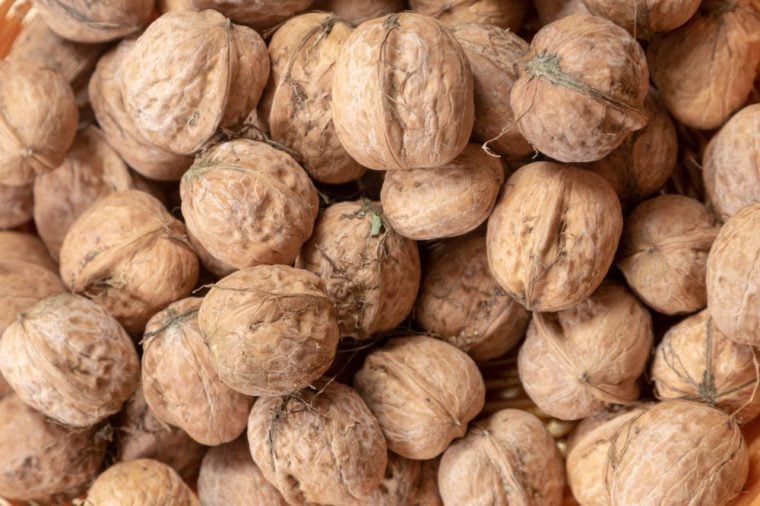
Walnuts
Another powerful nut! Walnuts contain alpha-linolenic acid, or ALA, a potent antioxidant that may reduce inflammation and other risk factors for heart disease, Morey explains. A handful of walnuts a day as a snack is an easy way to get this important nutrient. You can also scatter a few on top of a salad for a satisfying crunch, or add some to your oatmeal along with raisins or dried cranberries for a power breakfast.
Brush up on the surprising benefits of oatmeal.
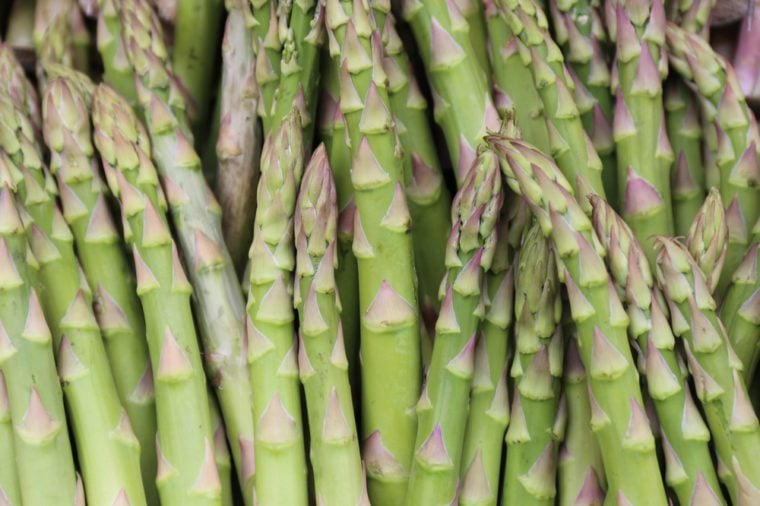
Asparagus
Asparagus boasts high amounts of vitamin K, which may play a role in regulating calcium in the body to promote bone and cardiovascular health, Morey says. “Sauté it with sugar snap peas and toss with whole wheat pasta, olive oil, lemon juice, and a bit of freshly grated Parmesan cheese and pepper for a meatless meal fit for a (very healthy) king or queen.
In case you were wondering, here’s why asparagus makes your pee smell.
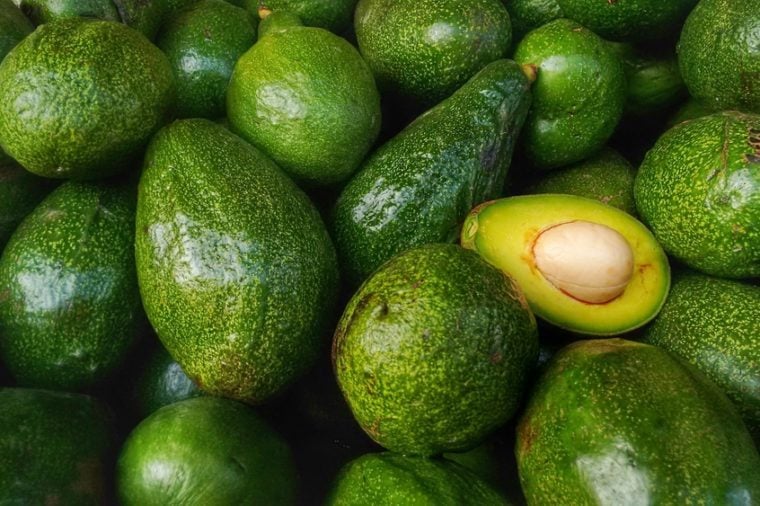
Avocados
Millennials may get teased for their love of avocado toast, but when it comes to heart health, they’re on to something. Research shows that people who ate an avocado a day had lower levels of LDL—the so-called bad cholesterol, according to a study published in the Journal of the American Heart Association. “Avocados are a good source of monounsaturated fat and soluble fibre,” says Tracy Severson, RD, a dietitian for the Center for Preventive Cardiology at the Knight Cardiovascular Institute and instructor of Medicine in the division of cardiovascular medicine at Oregon Health & Sciences University in Portland. “But they have a lot of calories, so it’s important to watch the portions.”
Discover more surprising benefits of avocado that make it part of a healthy diet.
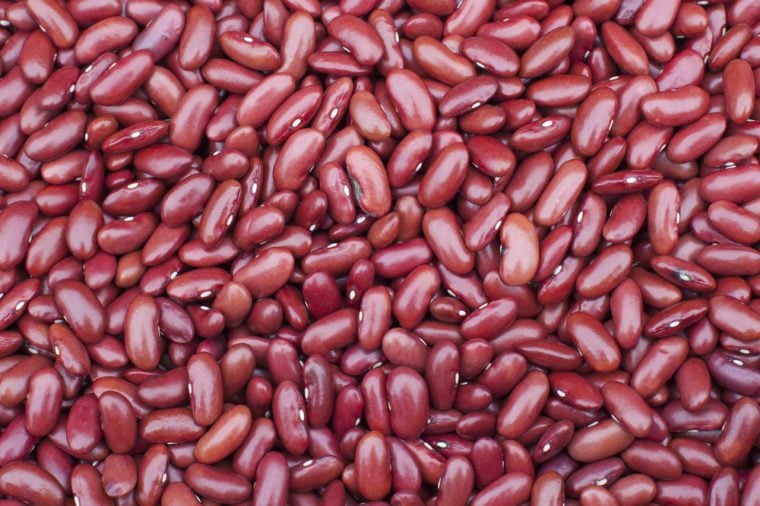
Beans
These versatile legumes contain more protein than any other plant food—just one cup provides a quarter of what we need each day, Morey says. They also provide heart-healthy and stress-busting B vitamins, iron, and all-important calcium. Plus, they are considered “nature’s scrub brush” because one serving’s 15 grams of fibre goes through the intestines, sops up cholesterol and takes it away. Use beans in soups and stews or create a vegetarian chili with kidney beans, tomatoes, carrots, celery, and a little bit of hot pepper. Puree a rinsed and drained can of white beans with two tablespoons of olive oil, a small clove of garlic, and salt and pepper for a Mediterranean-style veggie dip.
Find out how to read nutrition labels like a pro.
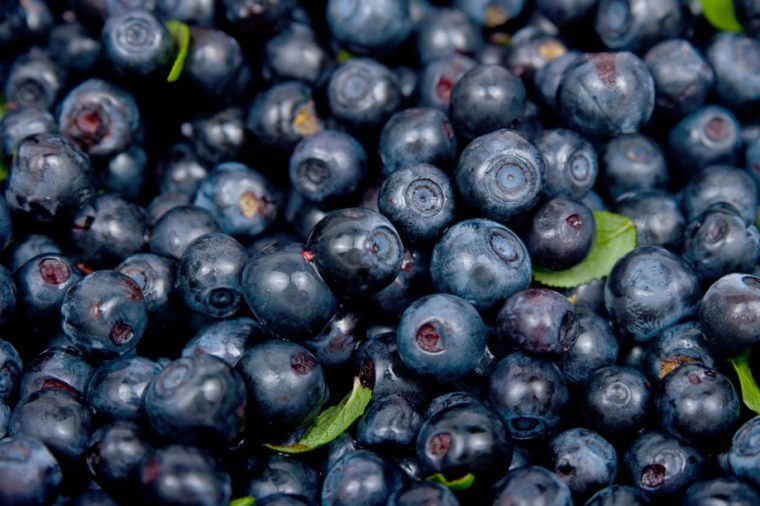
Blueberries
Almost all fruit is good for you—cherries, strawberries, mangos, peaches—yum! But these blue-hued beauties work overtime to provide you with antioxidants and vitamin C, both potent stress busters, Morey explains. They’re low in calories and sugar, so you can snack on them to your heart’s content without an ounce of guilt (or fat). Blueberries are also a good source of fibre, which can help relieve the cramps and constipation that can occur when you’re stressed out. Pile ’em on cereal, eat them fresh from the basket, or blend them with some plain yogurt, a banana, and some ice for a fabulous smoothie.
Here’s why wild blueberries may be an even healthier choice.
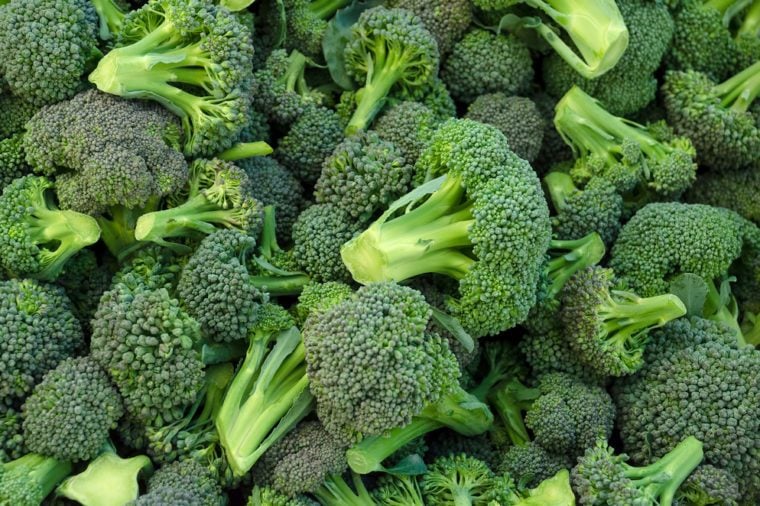
Broccoli
Broccoli is packed with vitamins K and C, and is an antioxidant powerhouse, Morey says. Antioxidants sop up damaging free radicals that increase the risk for heart disease and other conditions. Steam broccoli in the microwave (rinse and chop it, place it in a glass or other nonreactive bowl, and cover it with a damp paper towel, not plastic wrap) for a few minutes for optimal nutrition. Add a squeeze of lemon juice, a drizzle of extra-virgin olive oil, and, if you dare, a sprinkle of red pepper flakes for punch, and you’ve got yourself a sublime yet simple side dish.
Read up on the foods you should be eating raw.
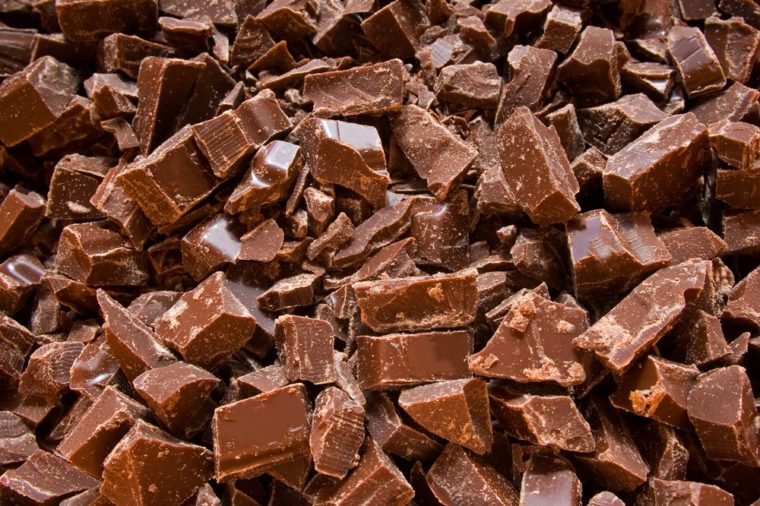
Chocolate
Dark chocolate (at least 75 per cent cocoa; 85 per cent is best) can be heart-healthy, Morey says. Dark chocolate is rich in healthful flavonoids, particularly flavonols which can help lower risk of heart disease, according to the American Heart Association (AHA). What’s more, chocolate or cocoa may lower risk of insulin resistance and high blood pressure in adults, the AHA states.
Learn about the risk factors for heart disease—and how to control them.
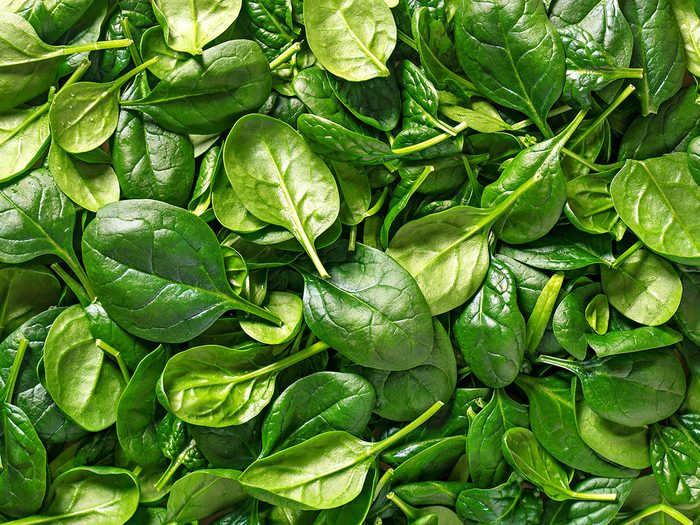
Leafy greens
Spinach and turnip tops provide iron plus lots of vitamin C, both good for strong bones, teeth, and hair, and vitamin A and magnesium, both of which are excellent at helping you maintain calm. “They are also high in vitamin K and folate or folic acid,” Morey says. Sauté one or more type of greens with lemon or orange juice and garlic, or purée with a little low-sodium chicken or veggie broth and white beans for a satisfying soup.
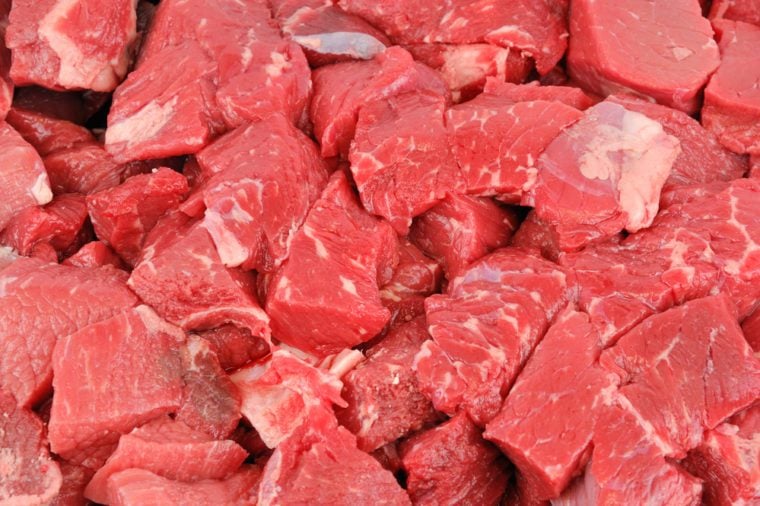
Lean beef
Surprised this is on the list after hearing admonitions from experts about avoiding the red stuff? Don’t be. Beef is loaded with zinc, iron, and B vitamins (not to mention protein), Morey says. It is also satiating, meaning you feel fuller longer (hunger pangs can cause irritability and anxiety). Avoid fatty cuts, and stick to lean cuts like flank and skirt steak, and 95 per cent lean ground beef. Or, look for cuts marked “round” or “loin,” such as top sirloin, bottom round (great for pot roast), and tenderloin—they are the kindest cuts in terms of fat content. And limit your intake to four to six ounces when you do enjoy it.
Here are more iron-rich foods you should consider adding to your diet.
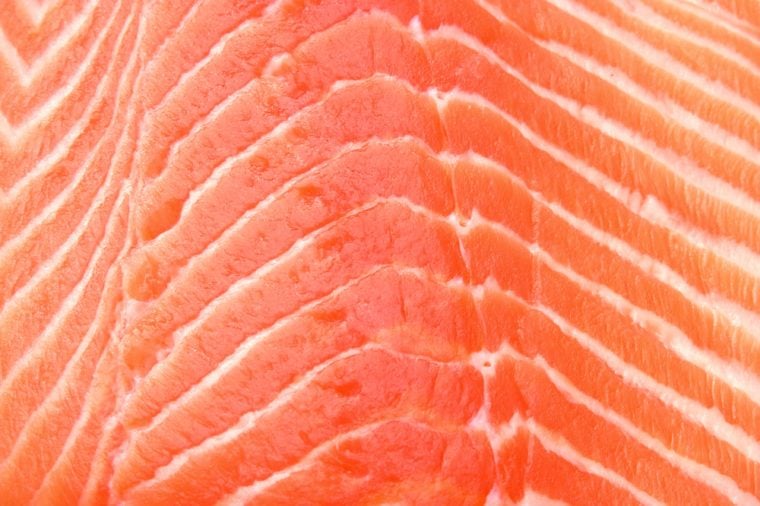
Salmon
Like many kinds of fish, salmon is loaded with B vitamins, particularly the renowned stress fighters B6 and B12. In fact, B12 is one of the most important vitamins in terms of serotonin production; a vitamin B12 deficiency can even lead to depression. Heart-healthy omega-3 fatty acids are also prevalent in salmon, Morey says. Alaskan wild is the best; farm-raised is the least desirable. The American Heart Association recommends eating fish (particularly fatty fish like salmon) at least twice a week to derive heart health benefits. Grill or pan-roast the fish, and serve on a bed of leafy greens with a side of lentils and carrots for a true power meal.
Find out the healthiest fish you can eat.
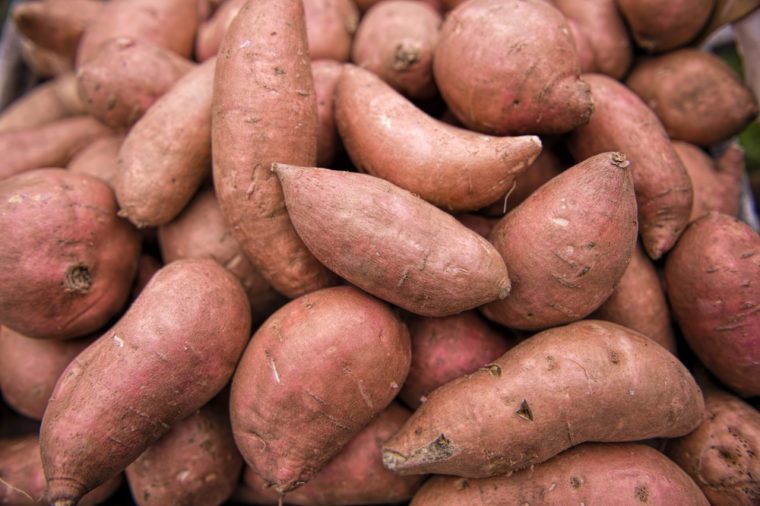
Sweet potatoes
Talk about a nutritional powerhouse! The more colour a veggie has, the better it is for you, according to nutritionists—and sweet potatoes might be the brightest of all. Potent antioxidants found in sweet potatoes help to shield our hearts, Morey says. Plus, their sweet taste makes them delicious enough to eat for dessert. But if you don’t want to go that far, try chunking them up into one-inch squares, roasting them at a high heat (400° F) for about 30 minutes, and then tossing them with some chopped prunes for a tempting and unique side dish next to roasted chicken or turkey—or as a vegetarian meal on its own.
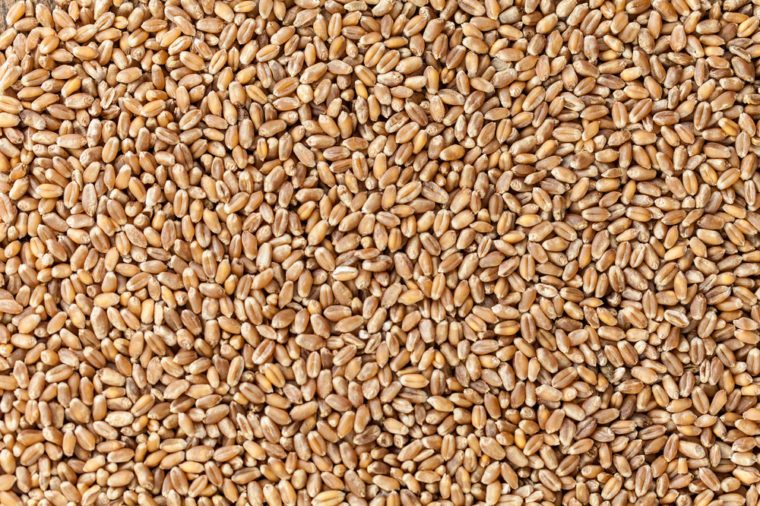
Whole grains
Cracked wheat, barley, farro, millet, and quinoa are just a few of the whole grains you can cook with and enjoy in all sorts of dishes. Whole grains digest slowly, keeping you feeling fuller, longer, Morey says. Plus they boost serotonin levels and make you feel happy—and they brighten your mood because they’re so delicious! A half-cup serving of any whole grain alongside a serving of veggies and lean protein should have you strolling on the sunny side of the street in no time. Follow packaging directions for preparation, but realize that most whole grains don’t require any special technique. However, toasting them in a dry pot for a few minutes before adding water adds depth of flavour.
Find out the best foods to boost your mood.
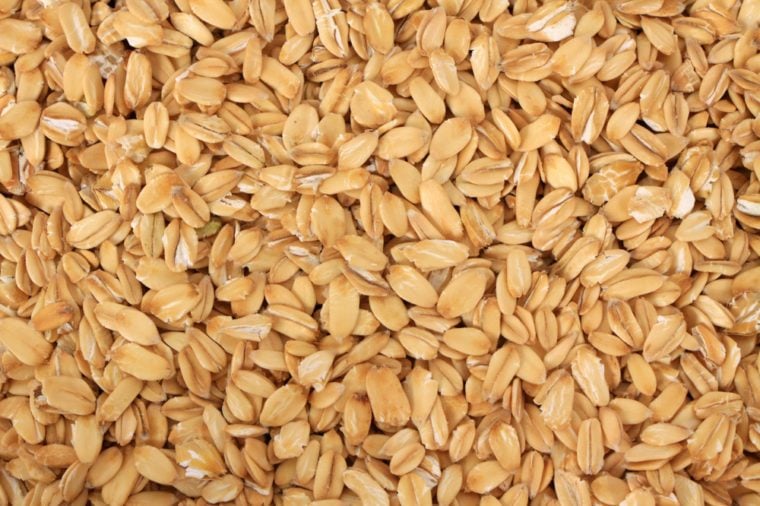
Oats
Oats contain a high proportion of soluble fibre, which reduces “bad” LDL cholesterol, Morey says.
Here are more high-fibre foods worth adding to your cart.
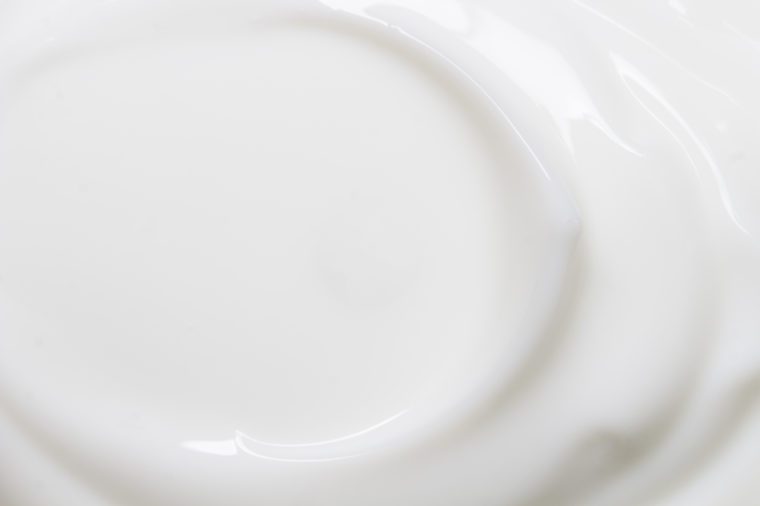
Yogurts and spreads
Yogurts and spreads containing plant sterols (similar to good cholesterol) can reduce blood levels of LDL cholesterol by up to 10 per cent, Morey says.
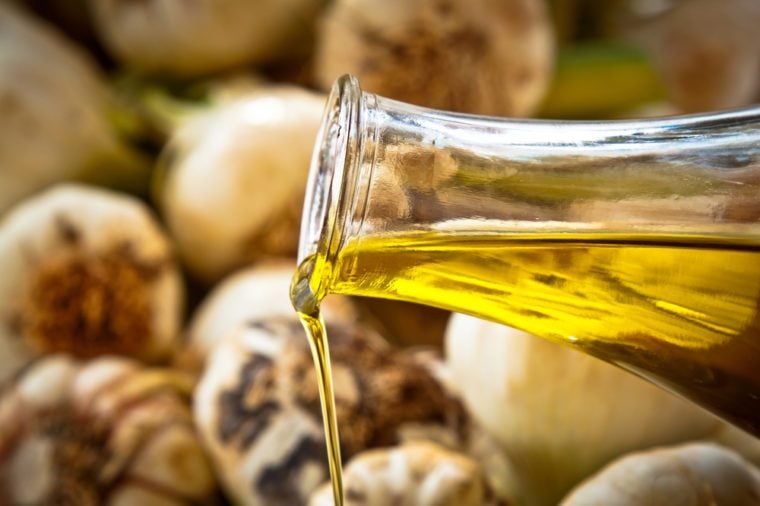
Olive oil
Extra virgin olive oil offers a potent mix of antioxidants that reduce “bad” LDL cholesterol while leaving your “good” HDL cholesterol untouched. “While overall it can be a healthier alternative to other saturated fats, it’s still important to use fats in moderation,” Morey adds.
Get to know the healthiest cooking oils on the market.
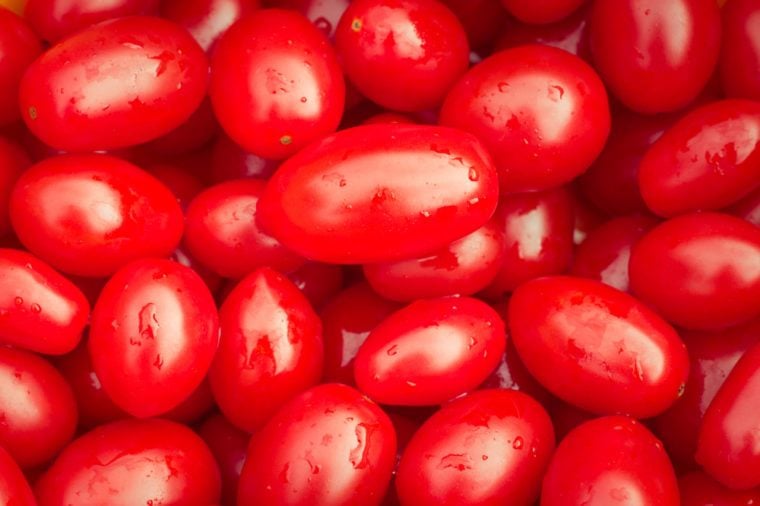
Tomatoes
Tomatoes and tomato paste are packed with vitamins and the antioxidant lycopene, which has beneficial effects on the heart, Morey says.
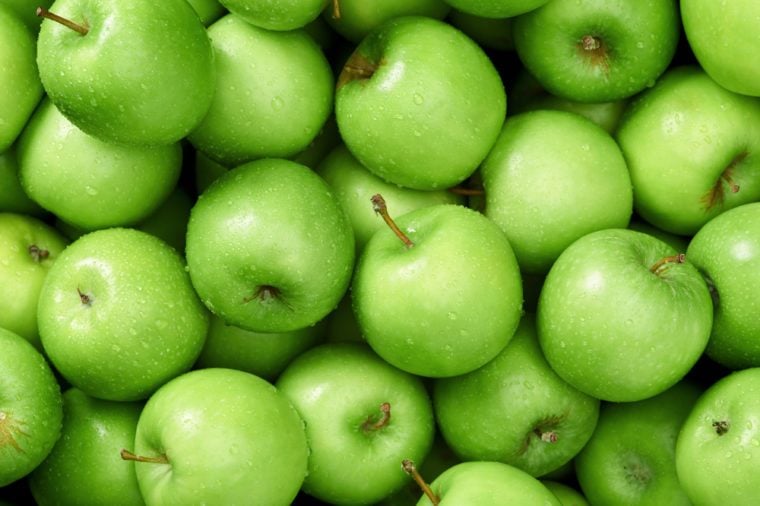
Apples
An apple a day may really keep the doctor away! “Apples contain soluble fibre, which can help lower cholesterol, in addition to polyphenols, a group of phytochemicals known for their antioxidant properties,” Morey says.
Brush up on the health benefits of apples.
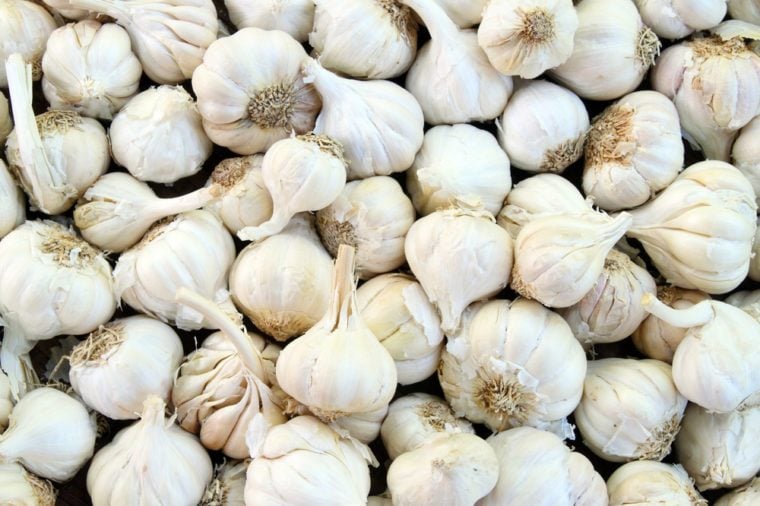
Onions and garlic
Onions and garlic help reduce blood cholesterol, as well as improving circulation and discouraging blood clotting, Morey says.
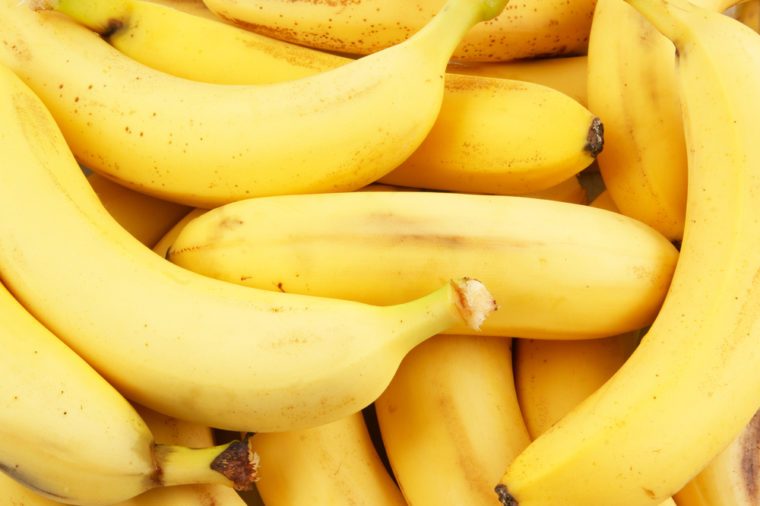
Bananas
Foods that are high in potassium can help keep blood pressure in check, the American Heart Association points out, and bananas are one of the richest dietary sources of this nutrient. A medium banana has about 420 mg of potassium—approximately one-tenth of the daily recommended intake, Morey says.
Read up on how bananas can reduce your risk for a heart attack.
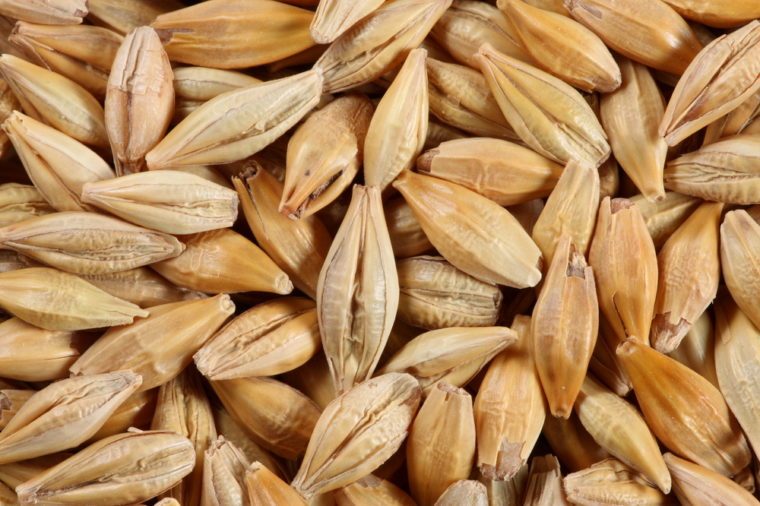
Barley
Barley can be one of the best foods for your heart: a healthy whole grain high in antioxidants, vitamins, and minerals. The “can be” is because much of the barley eaten in North America is called pearled or pearl barley, which is partially refined. The pearling process removes part of the bran layer, which means the end product is no longer whole grain and is lower in heart-healthy fibre. “Look for whole hulled barley, which has more fibre,” says Severson.
Check out 30 painless ways to increase dietary fibre.
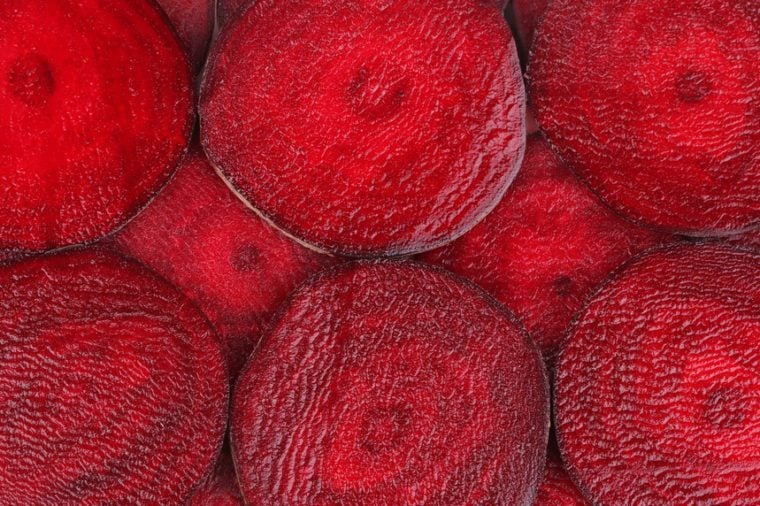
Beets
Beets are a good source of nitrates, which can help reduce blood pressure and increase exercise endurance, Morey says. Beets are also full of anthocyanins, which are anti-inflammatory, and help reduce the risk of coronary heart disease. Studies have found that people who drink beet juice improve their exercise endurance and lower blood pressure in people with heart failure.
While beets are packed with healthy nutrients, they can also have some surprising side effects.
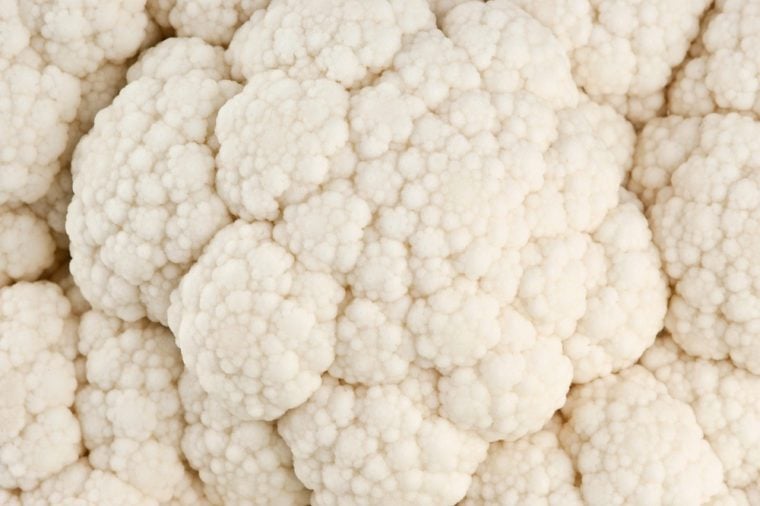
Cauliflower
Cauliflower is a cruciferous vegetable high in fibre, which can help lower blood pressure, and vitamin K, which helps boost circulation. But one caveat: Vitamin K helps blood clot, and people taking blood-thinning medication should check with their physicians about how much cauliflower is safe to eat to make sure it doesn’t interfere with a drug’s effects, Morey adds. “For most people cauliflower is fine, and a great source of nutrients and fibre,” she says.
Here are 14 food parts you should never throw out.
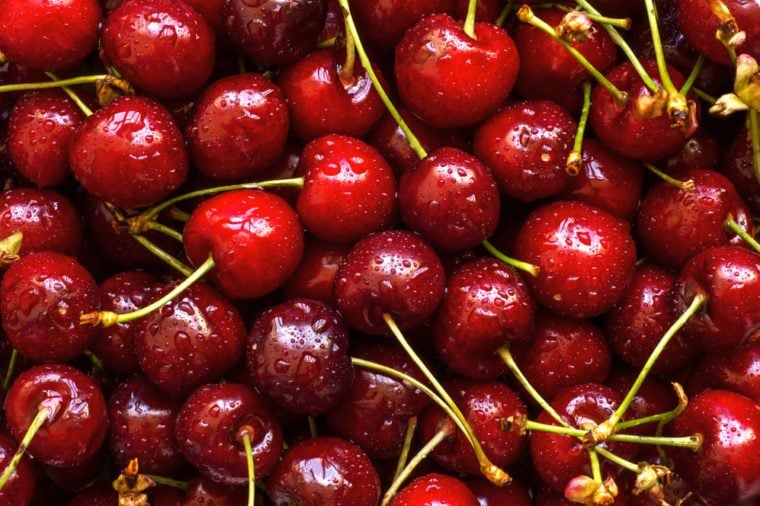
Cherries (tart)
Tart cherries’ bright red colour comes from anthocyanins, powerful antioxidants researchers have attributed to the fruit’s unique health properties, from anti-inflammatory and heart health benefits to reduced post-exercise muscle and joint pain, Morey says. And the benefits also apply to tart cherry juice! Research in Food & Function found that 8 ounces of 100 per cent tart cherry juice—equivalent to about 50 tart cherries—drank each day for four weeks significantly reduced markers of inflammation that are associated with chronic disease among overweight and obese adults.
Find out if cherry juice can really help arthritis sufferers.
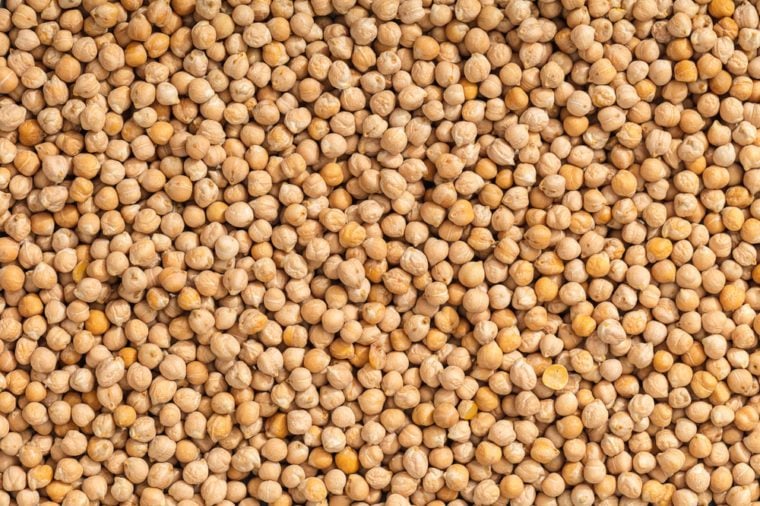
Chickpeas
Rich in both potassium and fibre, eating chickpeas can help regulate cholesterol and blood pressure. “If you eat chickpeas—or other beans or legumes—a couple of times a week as opposed to a steak or hamburger, you’ll be better off since the chickpeas are high in fibre and healthy fats,” says Alice Lichtenstein, a senior scientist and director of the Cardiovascular Nutrition Laboratory at Tufts University in Boston.
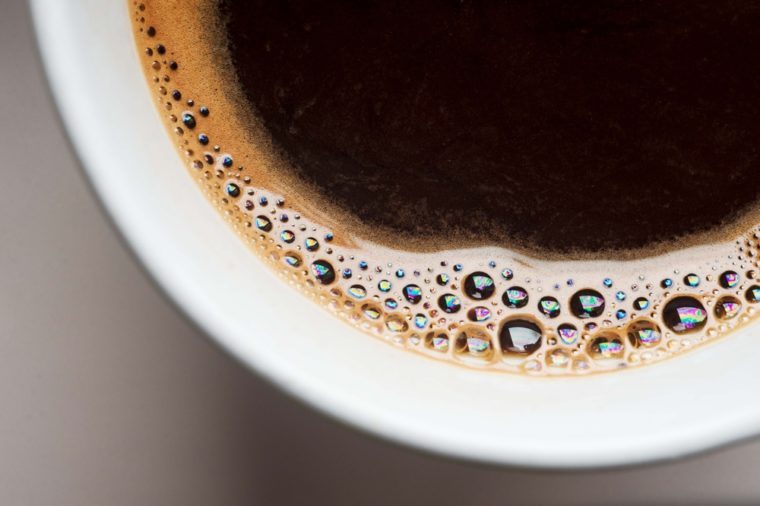
Coffee
Surprised? The research and recommendations about coffee have been all over the place, with some studies suggesting the beverage is harmful to health and others claiming it’s healthy. But according to the American College of Cardiology, coffee might be helpful in reducing the risk of arrhythmias, heart disease and stroke. Don’t overdo it, cautions Morey. “The current conservative recommendation is three cups of coffee per day.”
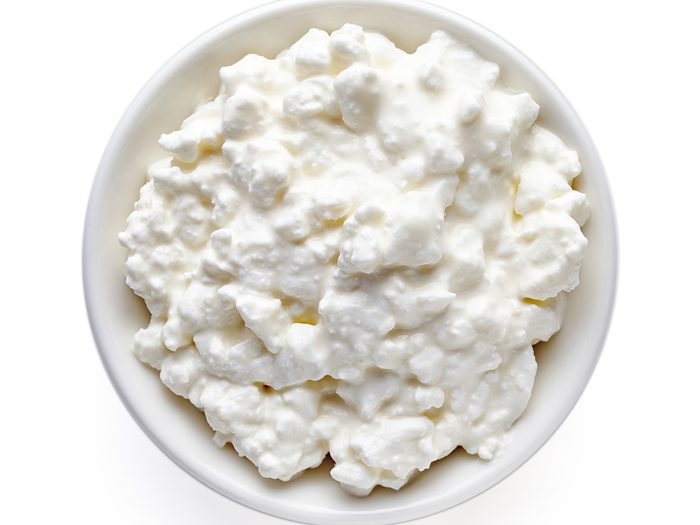
Cottage cheese
It may be best known as an old-fashioned diet food (although it’s enjoying a bit of new popularity), but cottage cheese is one of the best foods for your heart, too. “Low and nonfat dairy products, like low-fat cottage cheese, are good sources of calcium and high-quality protein,” says Lichtenstein. “Choose low sodium options as regular versions can have around 400 mg for just have a cup, which equals about 20 per cent of our sodium daily recommendation,” Morey adds.
Find out the best sources of protein, according to Canada’s Food Guide.
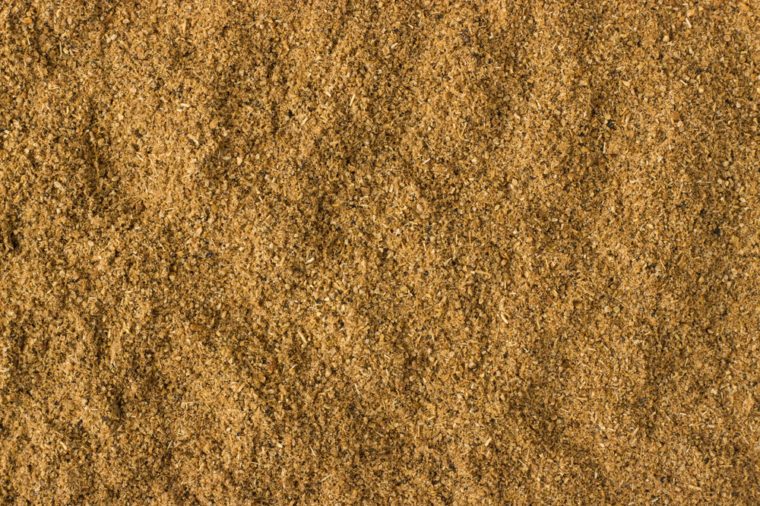
Cumin
Cumin has been found to have powerful effects on heart health, Morey says. A study published in the journal Complementary Therapies in Clinical Practice found that overweight or obese women who consumed just half a teaspoon of this spice daily reduced their LDL (bad) cholesterol and triglycerides, and raised levels of good HDL cholesterol, too.
Discover more herbs and spices that may have healing properties.
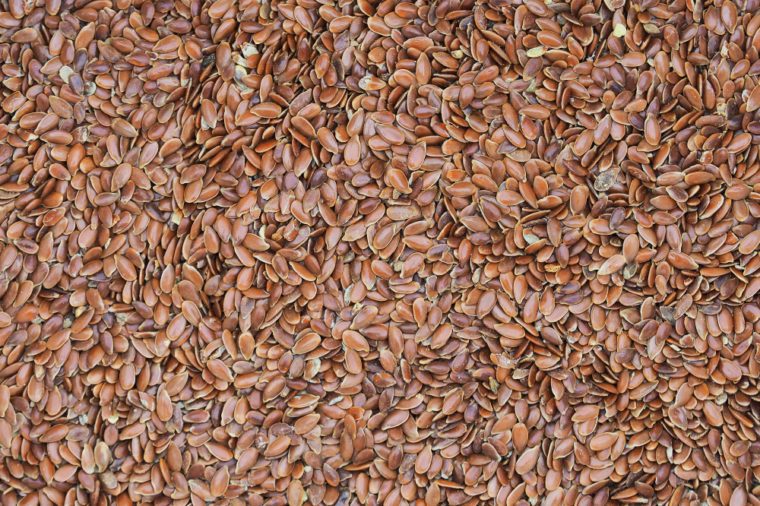
Flaxseed
These healthy seeds are a great way to add fibre to foods and are a good source of heart-healthy polyunsaturated fats, including omega-3 fatty acids. While most omega-3’s come from fish and algae, flaxseeds are one of the few good plant sources. “But with the flax, you have to make sure the seeds are ground into a meal,” says Severson. “We can’t break down the little tiny seeds on our own.”
Don’t miss our ultimate guide to healthy grocery shopping.
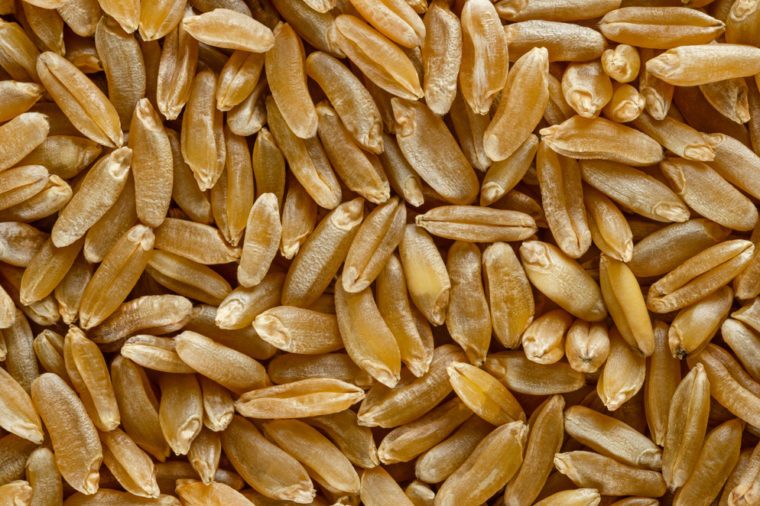
Kamut
If you want to expand your whole-grain repertoire, kamut is a good grain to try, Morey says. Eating kamut instead of other, only semi-whole grain products helped reduce cardiovascular risk factors like total cholesterol and LDL, and improved potassium and magnesium levels, she says.
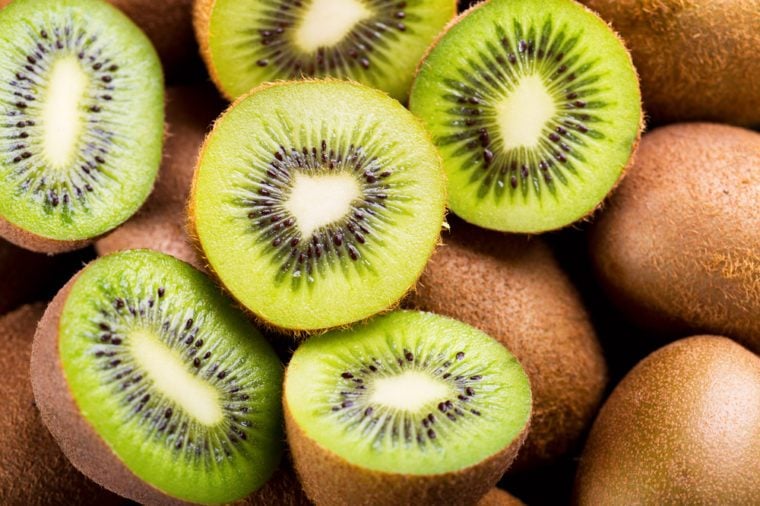
Kiwi
Eating two to three kiwis a day can help reduce harmful blood triglyceride levels, Morey says. Even one kiwi a week can have an effect. Plus the fruit is rich in vitamins C and E, and minerals potassium, magnesium, copper and phosphorous. It helps raise HDL—good cholesterol—levels, too. “If you’re up for eating the skin, you can double the amount of fibre you get from this fuzzy fruit.”
Find out the 10 worst foods for cholesterol.
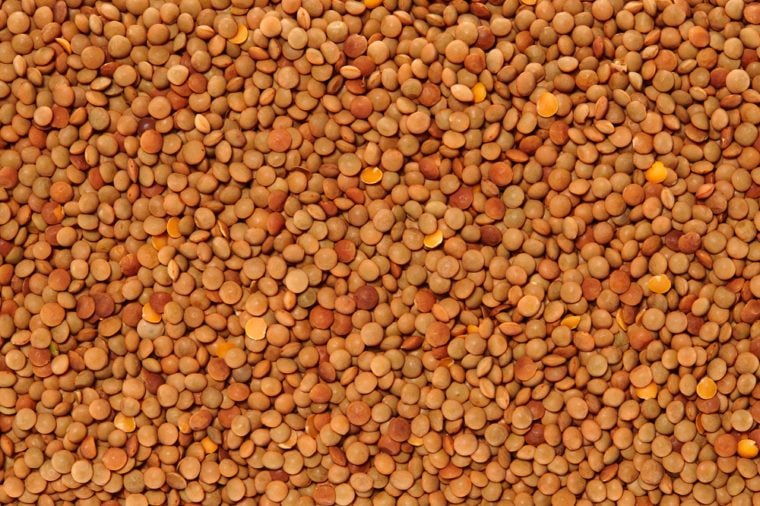
Lentils
Like beans and chickpeas, lentils are rich in fibre and low in fat, with lots of compounds that help reduce cholesterol, making them one of the best foods for your heart. “Any sort of dried bean or lentil is a great source of soluble fibre and protein,” says Severson. “Replacing meat with plant protein gives a significant cardiovascular benefit.”
Feed your brain with this expert-recommended MIND Diet meal plan.
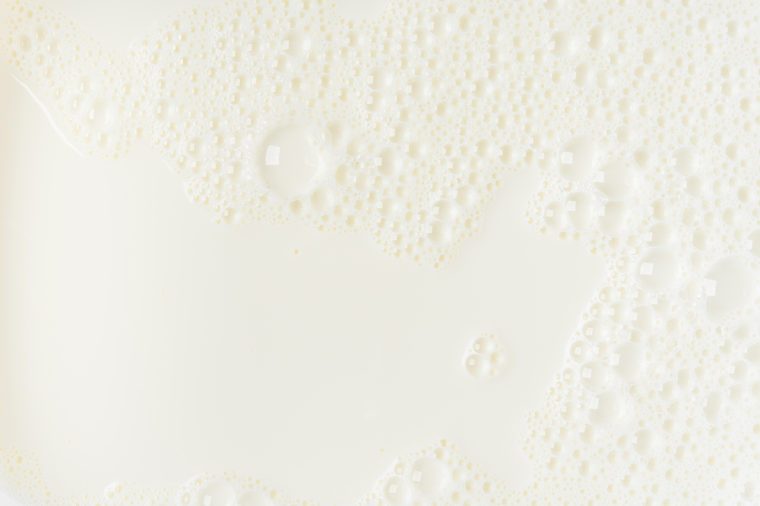
Milk
“Dairy milk is really important for blood pressure management because of the calcium and potassium it contains,” says Severson. Meaning, it’s not necessary to switch to alternative milk like oat, soy, or almond to keep your heart healthy. If you like cow’s milk, drink up—but choose low-fat products.
Learn to spot the signs you’re not getting enough calcium.
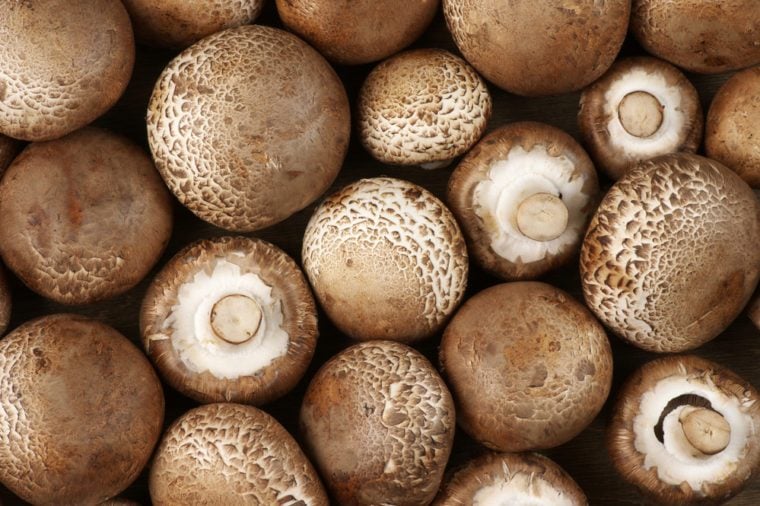
Mushrooms
A recent scientific review published in the Journal of the American College of Cardiology analyzed how popular foods help your heart. The authors gave a big thumbs-up to mushrooms for anti-inflammatory and antioxidant benefits. If you’re bored with the same white button mushrooms you’ve been slicing in your salad for years, expand your mushroom repertoire and learn the difference between white, cremini, and portobello mushrooms.
Here are 20 high antioxidant foods you should be eating.
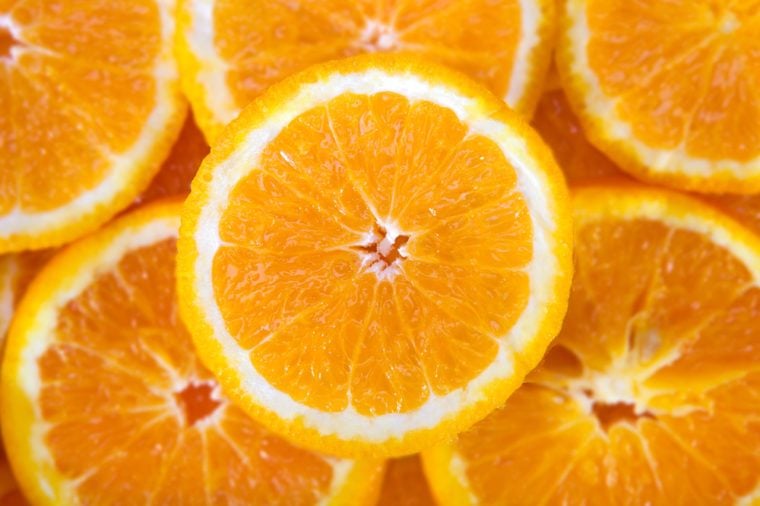
Oranges
“Citrus fruits are a good source of soluble fibre and vitamin C, an antioxidant,” says Severson. She explains that “antioxidants help decrease inflammation which can help with vascular function.”
Find out the healthiest fruit you can buy.
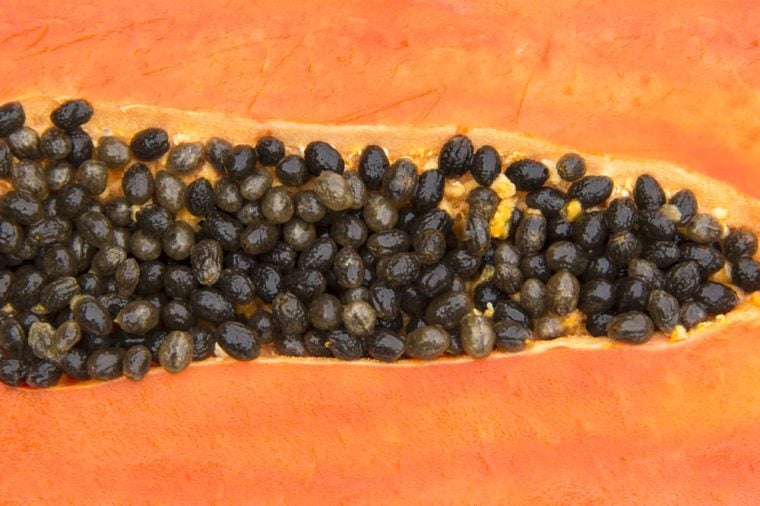
Papaya
According to Morey, just one serving of papaya provides 313 per cent of the Daily Value of vitamin C, which can help to prevent atherosclerosis and diabetes-related heart disease. Papaya is also one of the foods that are high in digestive enzymes which help your gut break down foods and deliver healthy vitamins, minerals, protein, and more to your body.
Here’s more expert advice on how to improve gut health.
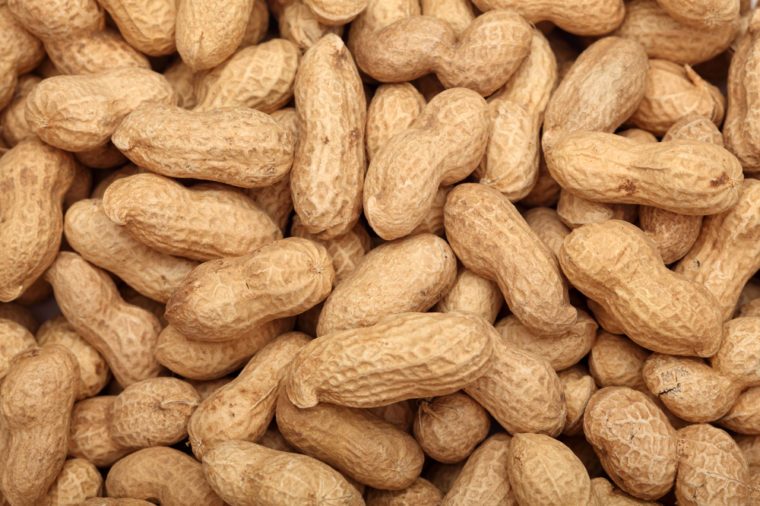
Peanuts
Common peanuts are less expensive than tree nuts like walnuts and almonds, but they confer exactly the same heart benefits. Researchers looking at the diets of people in the United States and abroad found that those who regularly ate peanuts and other nuts were far less likely to have died of heart disease—and any other causes—over the course of the study—published in JAMA Internal Medicine. For maximum health benefits, choose your peanuts unsalted and your peanut butter without added sugar.
Find out 25 ways sugar is making you sick.
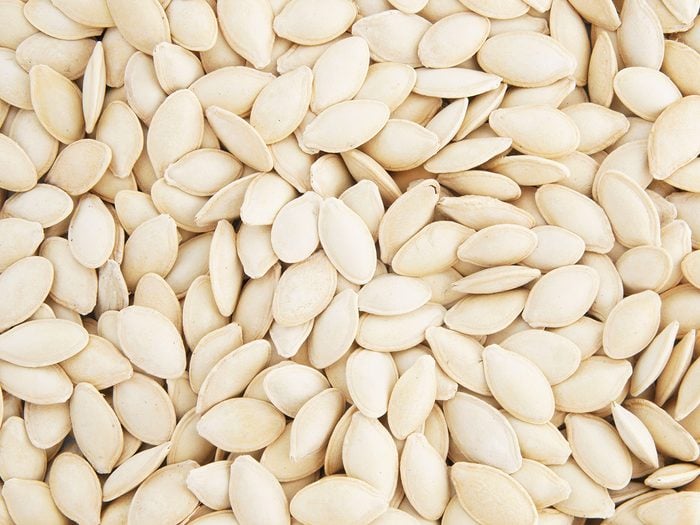
Pumpkin seeds
It doesn’t have to be the day after Halloween to enjoy pumpkin seeds, Morey says. “Pumpkin seeds are a good source of nutrients such as magnesium, zinc, and ALA, which may promote heart health by reducing blood pressure and oxidative stress, as well as increasing HDL.” Try roasting pumpkin seeds for a crunchy snack, or find pumpkin seed oil online or in gourmet stores. It makes for a great, nutty salad dressing.
Check out these natural remedies for high blood pressure.
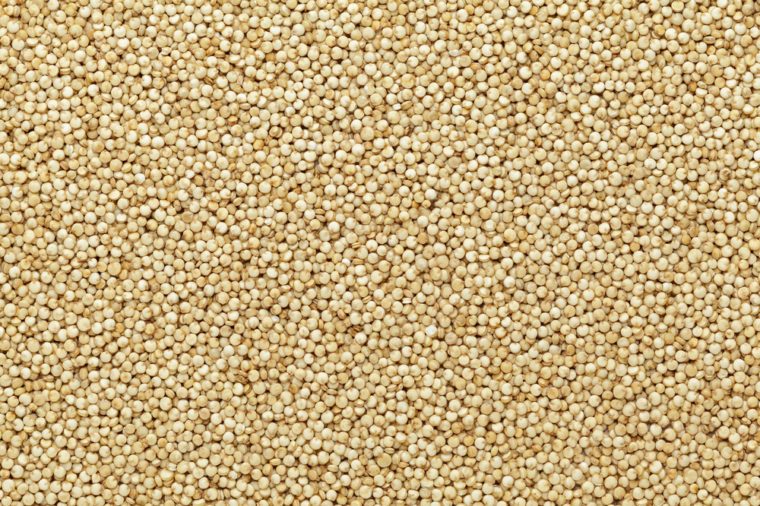
Quinoa
High in protein and gluten-free, studies show quinoa can help lower cholesterol. “It is also an excellent source of antioxidants,” Morey says.
Discover how it’s actually possible to reverse heart disease.
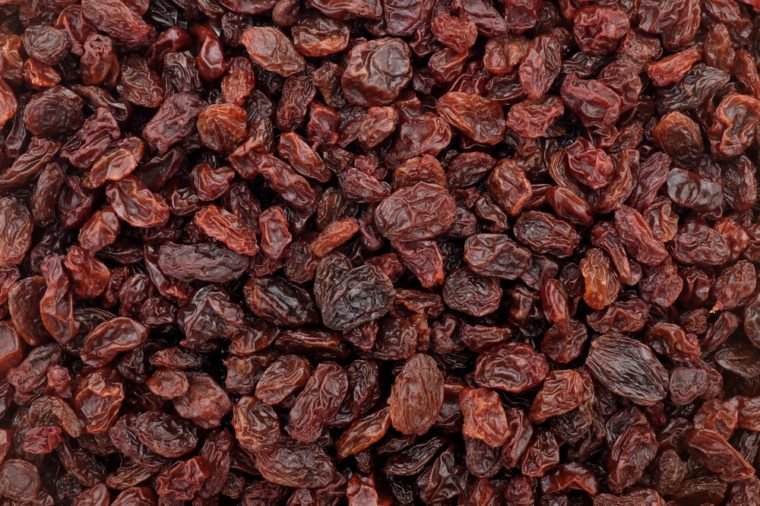
Raisins
Hungry for a snack? Reach for some raisins. Eating raisins reduces “bad” LDL cholesterol, blood pressure and blood sugar compared to other snacks with similar calories, and they also may help lower risk of heart disease, suggests a review study published in the journal Food & Nutrition Research.
Here are more “bad” foods you can stop demonizing.
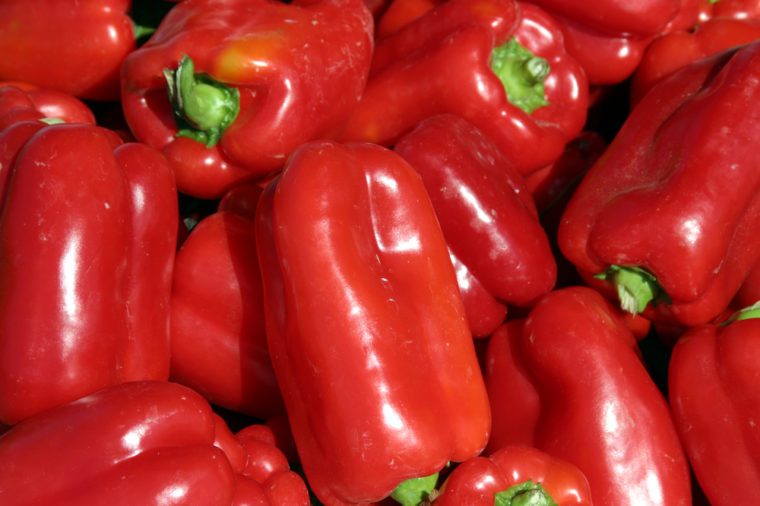
Red bell peppers
Red bell peppers are full of lycopene, Morey says. “They’re also a source of cholesterol-lowering soluble fibre and powerful antioxidant vitamins A and C, which are good for heart health.”
Don’t dismiss these clear signs you’re not eating enough vegetables.
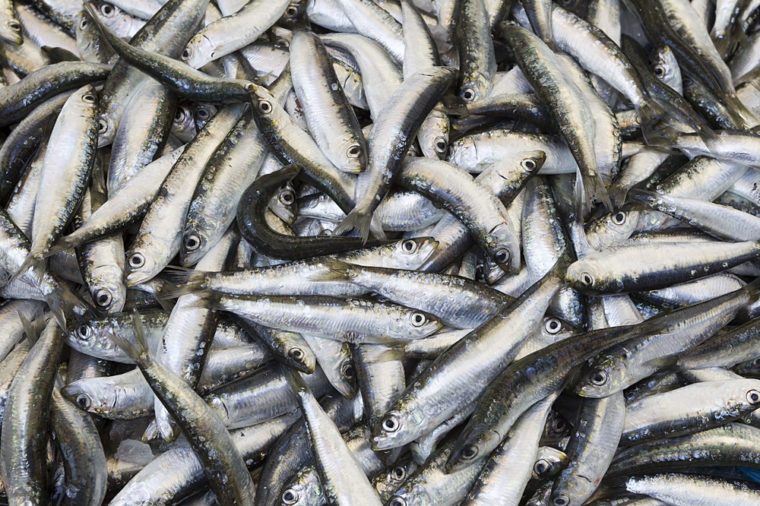
Sardines
Tuna and salmon may be among the most common fish eaten in Canada, but they’re hardly the only heart-healthy choices. Sardines—canned or grilled—are one of the richest sources of heart-healthy omega-3 fatty acids. “Sardines are so affordable, so sustainable. . . and so often overlooked as a source of omega-3s,” says Severson. Adds Lichtenstein, “It’s good to eat any kind of fish as long as it’s not battered or deep fat fried.”
Find out how to improve heart health in six easy steps.
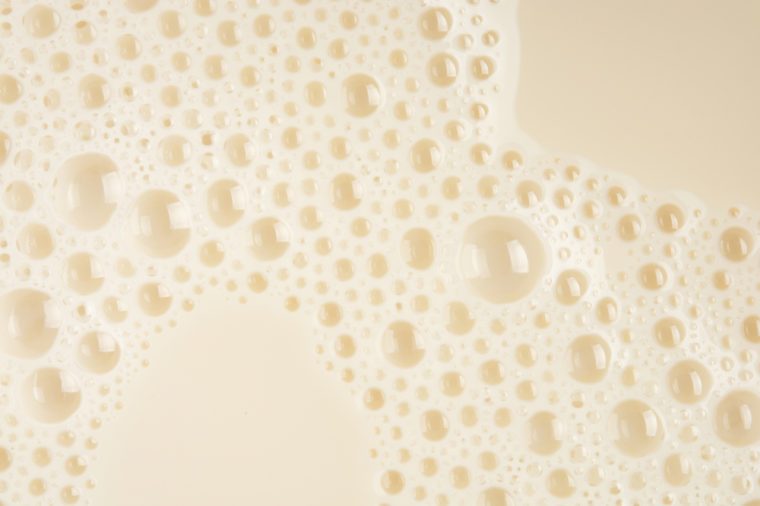
Soy milk
“For someone who doesn’t drink cow’s milk, soy milk would be my next preference,” says Severson. “It contains protein levels equal to cow’s milk, and some benefit from isoflavones.” Severson explains that other plant-based milk like almond and oat really don’t contain protein, and the calcium they do contain has been added, “so it’s the same as taking calcium supplements.” Plant proteins are generally a good alternative to animal products. Choose soy milk without a lot of added sugar for the most health benefits.
Watch out for the heart attack symptoms that are frequently misdiagnosed.
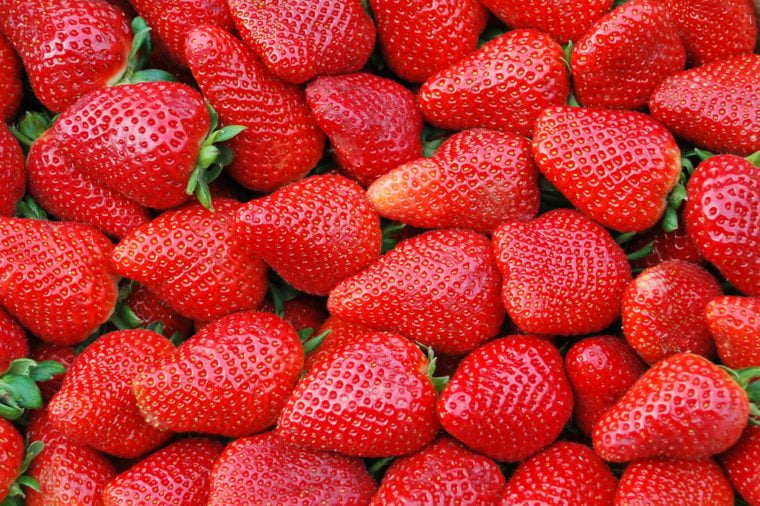
Strawberries
“Strawberries are great for cholesterol reduction,” says Severson. The anthocyanins that make blueberries blue and strawberries red are also good for blood pressure management, she explains.
Find out 20 more foods that lower blood pressure.
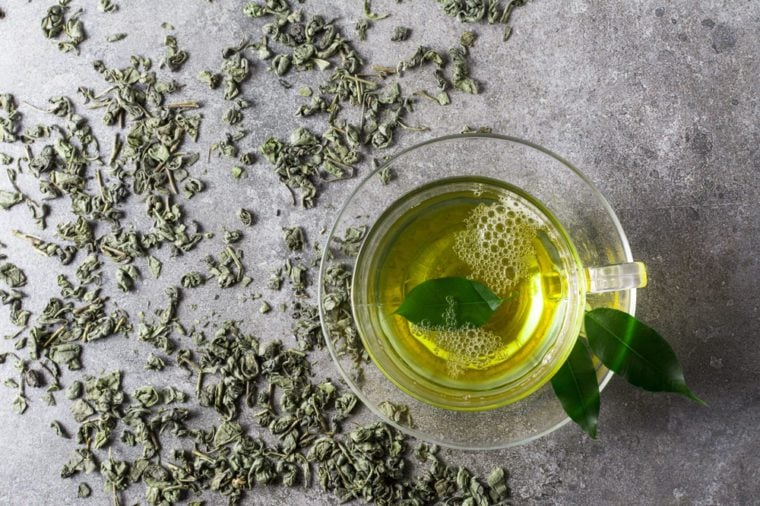
Tea
Brew a cuppa, green or black. According to the recent review of foods in the Journal of the American College of Cardiology, tea is one of the best foods for your heart. The beverage improves artery health, reverses blood vessel dysfunction, and reduces cholesterol.
Discover more health benefits of drinking tea every day.
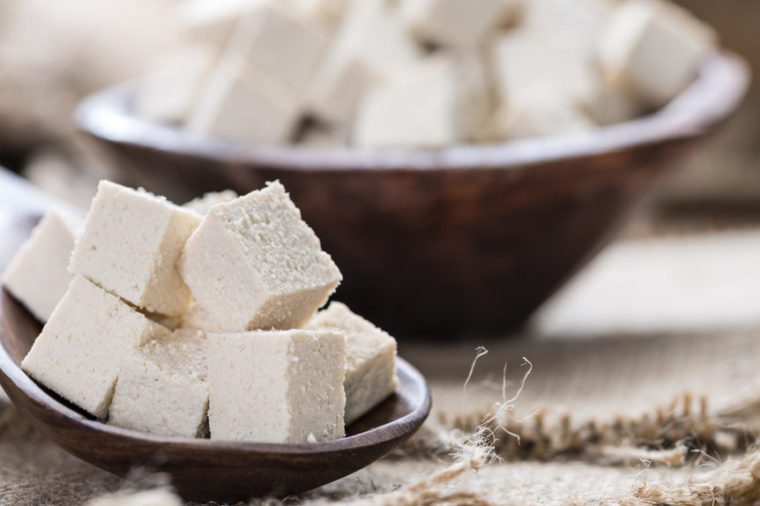
Tofu
“We used to think that soy was a little more powerful for reducing cholesterol,” says Severson; however, the new thinking doesn’t mean tofu and other soy products aren’t good for your heart. “If you’re using tofu to replace animal protein, you’re getting rid of the saturated fat from the animal. And both tofu and tempeh are also generally lower in sodium than other meat replacements.”
Here’s what happens to your body when you eat too much sodium.
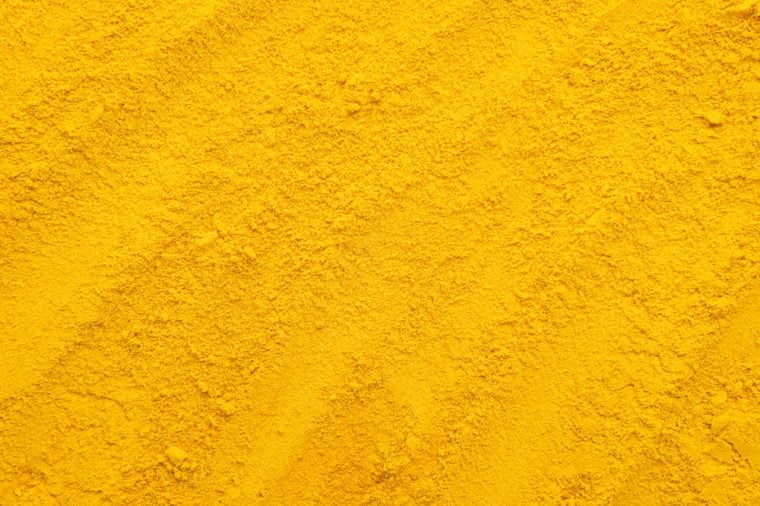
Turmeric
Curcumin, the active ingredient in turmeric, is responsible for the spice’s yellow colour. It’s also the reason this spice has a wide variety of heart benefits: It’s anti-inflammatory, anti-oxidant, anti-clotting, and has cardiovascular protective effects. Add turmeric to your spice rack and your food. But, cautions Severson, “you have to use a pretty hefty dose to get the benefits.”
Find out how to measure blood pressure accurately.
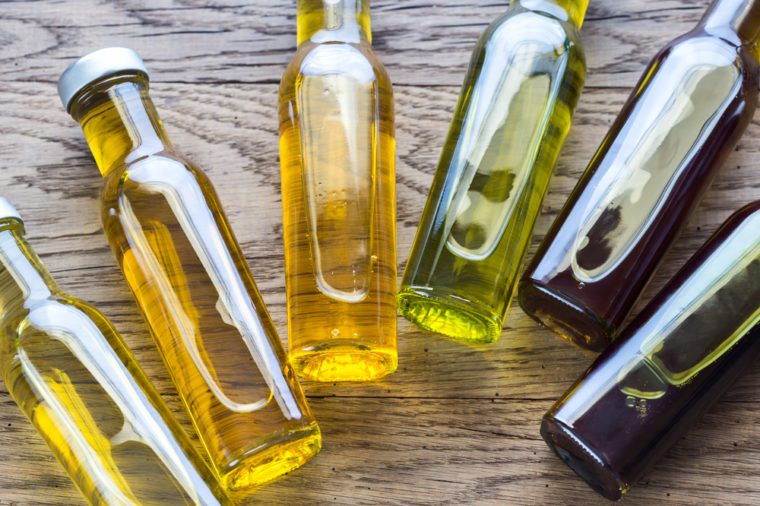
Vegetable oil
Olive oil gets all the heart-healthy attention, but “soybean, canola, and other vegetable oils are also excellent choices,” says Lichtenstein. Choose liquid vegetable oils rather than oils that are solid at room temperature like coconut oil. Vegetable oils are good sources of alpha-linolenic acid, an essential fatty acid that can’t be produced in the body but needs to be eaten as food. These acids have been shown to reduce the incidence of cardiac deaths, making vegetable oils one of the best foods for your heart, she says.
Discover the worst foods for your heart.
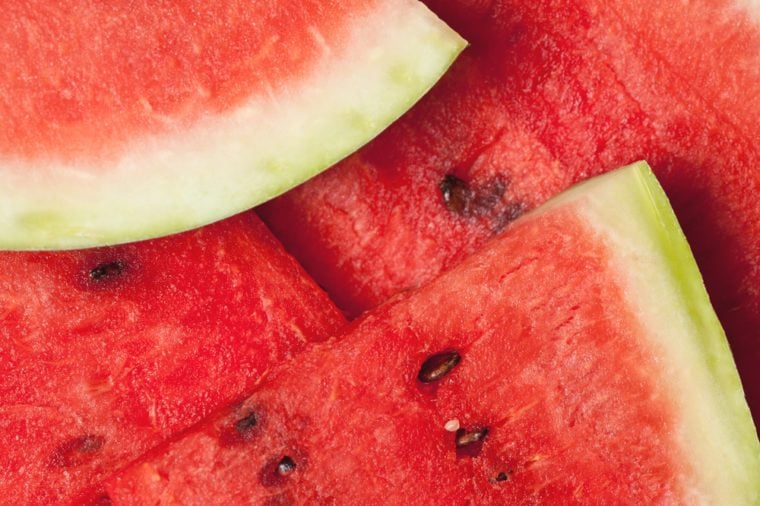
Watermelon
There’s more than water in watermelons—they’re packed with vitamins A, B6 and C, lots of lycopene, antioxidants and amino acids, says Boston-based nutritionist Dana Greene, RD. Watermelon also has a modest amount of potassium. “Plus it’s delicious, especially on a hot summer day,” Greene says.
Next, check out 50 everyday habits that slash your risk for heart disease.